|
|
|
Sort Order |
|
|
|
Items / Page
|
|
|
|
|
|
|
| Srl | Item |
| 1 |
ID:
088959
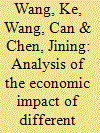

|
|
|
|
|
| Publication |
2009.
|
| Summary/Abstract |
Abatement cost is the main concern for climate change mitigation and the key factor for mitigation cost is technological change. This study established an integrated economic, energy, environmental, dynamic, computable general equilibrium (CGE) model representing endogenous technological change for China's climate change policy analysis. This study analyzed and compared the economic impact of different approaches to mitigation commitments as well as the potential role of technological change in the formulation of mitigation targets and commitments, taking into account China's climate policy-making needs based on the current international climate negotiation process. The results show that, absolute emission limits similar to the Kyoto Protocol will seriously impede the future economic development of China, while the impact of an 80% reduction in carbon intensity, forecast for 2050 based on the 2005 level, is relatively small. Technological change can promote economic growth, improve energy efficiency and reduce carbon intensity per unit of output through the substitution of production factors. Consequently it can reduce marginal abatement cost and related GDP loss by mitigation. At the same time it can increase mitigation potentials and extend the emission reduction amount, showing that consideration of the impact of technological change when deciding the emission reduction targets is necessary
|
|
|
|
|
|
|
|
|
|
|
|
|
|
|
|
| 2 |
ID:
088946
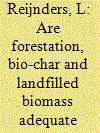

|
|
|
|
|
| Publication |
2009.
|
| Summary/Abstract |
Forestation and landfilling purpose-grown biomass are not adequate offsets for the CO2 emission from burning fossil fuels. Their permanence is insufficiently guaranteed and landfilling purpose-grown biomass may even be counterproductive. As to permanence, bio-char may do better than forests or landfilled biomass, but there are major uncertainties about net greenhouse gas emissions linked to the bio-char life cycle, which necessitate suspension of judgement about the adequacy of bio-char addition to soils as an offset for CO2 emissions from burning fossil fuels.
|
|
|
|
|
|
|
|
|
|
|
|
|
|
|
|
| 3 |
ID:
088971


|
|
|
|
|
| Publication |
2009.
|
| Summary/Abstract |
This paper examines peat power production in Ireland under the three pillars of energy policy-security, competitiveness and environment. Peat contributes to energy security-as an indigenous fuel, it reduces dependency on imports. During a period of low capacity margins, the operation of the peat plants is useful from a system security perspective. Peat generation is being financially supported by consumers through an electricity levy. The fuel also has high carbon intensity. It is not politically viable to consider peat on equal economic criteria to other plant types because of history and location. This paper reviews electricity generation through combustion of peat in Ireland, and quantifies the costs of supporting peat utilising economic dispatch tools, finding the subsidy is not insignificant from a cost or carbon perspective. It shows that while peat is beneficial for one pillar of energy policy (security), the current usage of peat is not optimal from a competitiveness or environmental perspective. By switching from the current 'must-run' mode of operation for peat to the 'dispatched' mode used for the other generation, significant societal savings (in the range €21 m per annum) can be achieved, as well as reducing system emissions by approximately 5% per year.
|
|
|
|
|
|
|
|
|
|
|
|
|
|
|
|
| 4 |
ID:
088950
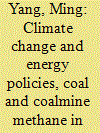

|
|
|
|
|
| Publication |
2009.
|
| Summary/Abstract |
The Chinese government has made many energy policies on coal, and coalmine methane (CMM) use. However, not all of these policies have effects or positive impacts. For example, it has been quite a few years since the national government made policies to encourage coalmine methane power to be sold to the grid. Practice showed that not any kilowatt of electricity was sold from a coalmine methane power plant to the grid in Sichuan and Guizhou Provinces as of December 2008. The objectives of this paper are to review and evaluate the Chinese government energy and climate policies that are related to coal and coalmine methane, analyze relevant policy barriers, and make recommendations to overcome these barriers and avoid policy failures. This paper provides the literature review, challenges, resources, policies and other updated information on China's CMM recovery and utilization. The paper concludes that China needs to further reform its energy and environment management system, engage provincial governments in CMM capture and use activities, and provide incentives to qualified engineers and skilled workers to work in remote coal mining areas. This paper transfers key messages to policy makers for them to make better CMM capture and use policies.
|
|
|
|
|
|
|
|
|
|
|
|
|
|
|
|
| 5 |
ID:
089005
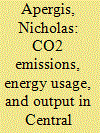

|
|
|
|
|
| Publication |
2009.
|
| Summary/Abstract |
This study extends the recent work of Ang (2007) [Ang, J.B., 2007. CO2 emissions, energy consumption, and output in France. Energy Policy 35, 4772-4778] in examining the causal relationship between carbon dioxide emissions, energy consumption, and output within a panel vector error correction model for six Central American countries over the period 1971-2004. In long-run equilibrium energy consumption has a positive and statistically significant impact on emissions while real output exhibits the inverted U-shape pattern associated with the Environmental Kuznets Curve (EKC) hypothesis. The short-run dynamics indicate unidirectional causality from energy consumption and real output, respectively, to emissions along with bidirectional causality between energy consumption and real output. In the long-run there appears to be bidirectional causality between energy consumption and emissions.
|
|
|
|
|
|
|
|
|
|
|
|
|
|
|
|
| 6 |
ID:
088993


|
|
|
|
|
| Publication |
2009.
|
| Summary/Abstract |
Households consume a large amount of indirect energy through the consumption of goods and services. This fact makes the quantitative analysis of indirect household energy consumption the foundation of energy policy design. This paper improves the compilation method of energy input-output tables, and establishes a sequence of energy input-output tables for China. Based on these tables, the indirect energy consumption of both rural and urban households is calculated. Then, with economic data for the year of 2005, the adjusted input-output price model is applied to evaluate how the alternative energy policies impact production prices, consumption prices, and real income of rural and urban households through the mechanism of indirect energy consumption by using electricity as an example. This research has practical implications for Chinese economy. The integration of energy-efficiency improvements and energy prices increase serves as a means to achieve both economic and energy conservation goals, and may also have a positive effect on residents' real income and a minimal effect on production prices.
|
|
|
|
|
|
|
|
|
|
|
|
|
|
|
|
| 7 |
ID:
089003
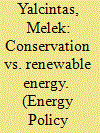

|
|
|
|
|
| Publication |
2009.
|
| Summary/Abstract |
State of Hawaii generates about 90 percent of its electricity from imported fossil fuel sources. Thus, there is pressure from both public and policy makers to reduce the State dependency on foreign fossil fuel sources. To this extend, there are incentives created at State and Federal level for both residential and commercial buildings to install photovoltaic (PV) systems. Although such incentives are necessary for long-term objectives, it is shown in this study that retrofitting inefficient old building-equipment is another viable source to reduce the State of Hawaii's electricity demand. Four case studies are presented to illustrate that building-equipment retrofitting is a viable and necessary tool for increasing the energy efficiency of buildings. Each case study presents an equipment retrofit project electricity savings with its payback periods, and compares with equivalent electricity capacity and economics PV systems in Honolulu, Hawaii. The case studies show that energy savings from retrofit projects ranged from 28% to 61% for individual equipment retrofits. These results indicate that equipment retrofitting with energy-efficient alternatives is about 50% or more cost-effective than installing PV systems. This is so even when large renewable energy tax incentives provided by the Federal and State Governments are taken into account.
|
|
|
|
|
|
|
|
|
|
|
|
|
|
|
|
| 8 |
ID:
088952


|
|
|
|
|
| Publication |
2009.
|
| Summary/Abstract |
Despite the large contribution of individuals and households to climate change, little has been done in the US to reduce the CO2 emissions attributable to this sector. Motor vehicle idling among individual private citizens is one behavior that may be amenable to large-scale policy interventions. Currently, little data are available to quantify the potential reductions in emissions that could be realized by successful policy interventions. In addition, little is known about the motivations and beliefs that underlie idling. In the fall of 2007, 1300 drivers in the US were surveyed to assess typical idling practices, beliefs and motivations. Results indicate that the average individual idled for over 16 min a day and believed that a vehicle can be idled for at least 3.6 min before it is better to turn it off. Those who held inaccurate beliefs idled, on average, over 1 min longer than the remainder of the sample. These data suggest that idling accounts for over 93 MMt of CO2 and 10.6 billion gallons (40.1 billion liters) of gasoline a year, equaling 1.6% of all US emissions. Much of this idling is unnecessary and economically disadvantageous to drivers. The policy implications of these findings are discussed.
|
|
|
|
|
|
|
|
|
|
|
|
|
|
|
|
| 9 |
ID:
088980


|
|
|
|
|
| Publication |
2009.
|
| Summary/Abstract |
Applying the techniques of decomposition analysis we estimate the relative contribution of ten variables (termed 'key ratios') plus GDP to the change in UK road freight energy use over the period 1989-2004 inclusive. The results are best interpreted as an estimate of the percentage growth in energy consumption that would have resulted from the change in the relevant factor (e.g. length of haul) had the other factors remained unchanged. The results demonstrate that the main factor contributing to the decoupling of UK road freight energy consumption from GDP was the decline in the value of domestically manufactured goods relative to GDP. Over the period 1989-2004 this largely offset the effect of increases in GDP on road freight energy consumption. While the decline in domestic manufacturing was to some extent displaced by increases in imports, the net effect of these supply factors, together with shifts in the commodity mix, has been to reduce UK road freight energy consumption by 30.1%. The net effect on global carbon dioxide (CO2) emissions is likely to be somewhat less beneficial, since many freight movements associated with the manufacture of imported goods have simply been displaced to other countries.
|
|
|
|
|
|
|
|
|
|
|
|
|
|
|
|
| 10 |
ID:
089001
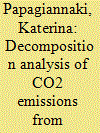

|
|
|
|
|
| Publication |
2009.
|
| Summary/Abstract |
The paper presents a decomposition analysis of the changes in carbon dioxide (CO2) emissions from passenger cars in Denmark and Greece, for the period 1990-2005. A time series analysis has been applied based on the logarithmic mean Divisia index I (LMDI I) methodology, which belongs to the wider family of index decomposition approaches. The particularity in road transport that justifies a profound analysis is its remarkably rapid growth during the last decades, followed by a respective increase in emissions. Denmark and Greece have been selected based on the challenging differences of specific socio-economic characteristics of these two small EU countries, as well as on the availability of detailed data used in the frame of the analysis. In both countries, passenger cars are responsible for half of the emissions from road transport as well as for their upward trend, which provokes the implementation of a decomposition analysis focusing exactly on this segment of road transport. The factors examined in the present decomposition analysis are related to vehicles ownership, fuel mix, annual mileage, engine capacity and technology of cars. The comparison of the results discloses the differences in the transportation profiles of the two countries and reveals how they affect the trend of CO2 emissions.
|
|
|
|
|
|
|
|
|
|
|
|
|
|
|
|
| 11 |
ID:
088976


|
|
|
|
|
| Publication |
2009.
|
| Summary/Abstract |
In this paper, several designs of hybrid PV-wind (photovoltaic-wind) systems connected to the electrical grid, including the intermittent production of hydrogen, are shown. The objective considered in the design is economical to maximise the net present value (NPV) of the system.
A control strategy has been applied so that hydrogen is only produced by the electrolyser when there is an excess of electrical energy that cannot be exported to the grid (intermittent production of hydrogen).
Several optimisation studies based on different scenarios have been carried out. After studying the results - for systems with which the produced hydrogen would be sold for external consumption - it can be stated that the selling price of hydrogen should be about 10 €/kg in areas with strong wind, in order to get economically viable systems.
For the hydrogen-producing systems in which hydrogen is produced when there is an excess of electricity and then stored and later used in a fuel cell to produce electricity to be sold to the grid, even in areas with high wind speed rate, the price of electrical energy produced by the fuel cell should be very high for the system to be profitable.
|
|
|
|
|
|
|
|
|
|
|
|
|
|
|
|
| 12 |
ID:
088949


|
|
|
|
|
| Publication |
2009.
|
| Summary/Abstract |
Wind energy is often said to have positive effects on employment, but few studies have systematically dealt with this matter. This article presents estimates of direct wind energy employment in all EU countries, gathered for the first time. By using a thematic survey, the authors have been able to analyse aspects such as gender distribution, company profiles and the shortage of skilled workers reported by wind energy companies. The outcomes show that wind energy deployment creates a significant number of jobs (over 104,000 in 2008), and does so at a time when other energy sectors are shrinking. There is a clear relationship between MW installed and number of jobs, but the use of a single EU job/MW ratio is not feasible, due to differences in the export/import capacity. Wind turbine manufacturers-including major sub-components-are responsible for the lion's share of the jobs, and there is a marked prevalence of males in the workforce. The scarcity of specialist roles-project managers, engineers and O&M technicians-is not likely to be solved unless a series of educational, mobility and dissemination measures are put into practice.
|
|
|
|
|
|
|
|
|
|
|
|
|
|
|
|
| 13 |
ID:
088972


|
|
|
|
|
| Publication |
2009.
|
| Summary/Abstract |
This article implements a simple econometric approach to assess the effect of the environmental tax reforms introduced in Germany and the UK. Despite the very simple econometric approach adopted in this paper, in the case of the energy demand, our results do not differ markedly from those obtained from complicated multi-sectoral econometric models. In the case of the labour demand, our results differ from the estimates obtained from econometric models where the employment level is not directly influenced by the energy price. On the other hand, our results are more similar to those obtained from models where the level of employment is directly influenced by the energy price. Confirming the findings of Bosquet [2000. Environmental tax reform: does it work? A survey of the empirical evidence. Ecological Economics 34, 19-32] and OECD [2004. Environment and Employment: An Assessment Working Party on National Environmental Policy OECD, Paris], we conclude that environmental tax reforms can deliver substantial reductions in energy consumption while having small effects on the level of employment, effect which can be positive, depending on the size of the reduction in the labour costs and the value of cross-price elasticities.
|
|
|
|
|
|
|
|
|
|
|
|
|
|
|
|
| 14 |
ID:
088966
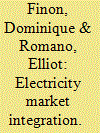

|
|
|
|
|
| Publication |
2009.
|
| Summary/Abstract |
In countries with a significant amount of low variable cost generation capacity, the integration of electricity markets poses a real problem with respect to consumers' interests. In such cases, consumers face a significant price rise compared with consumers in countries where low-cost capacities are lacking. This paper analyses this problem both in the short and long term, focusing on a market dominated by nuclear and hydro production. When there are too many restrictions on new capacity developments in low-cost technologies, market integration will lead to surplus redistribution without any production reallocation. This really makes it legitimate to contemplate redistributive compensations towards local consumers in countries which benefited from low variable cost generators at the moment of liberalisation. This paper examines two alternative ways of rent reallocation, one by income with a windfall tax on nuclear producers and the allocation of this revenue to energy efficiency policy funds, and another by price by giving drawing rights on the existing nuclear generators' production to small commercial and domestic consumers, at a level equivalent to the one necessary to maintain regulated prices.
|
|
|
|
|
|
|
|
|
|
|
|
|
|
|
|
| 15 |
ID:
088958


|
|
|
|
|
| Publication |
2009.
|
| Summary/Abstract |
This study probes nexus between electricity supply, employment and real GDP for India within a multivariate framework using autoregressive distributed lag (ARDL) bounds testing approach of cointegration. Long-run equilibrium relationship has been established among these variables for the time span 1970-71 to 2005-06. The study further establishes long- and short-run Granger causality running from real GDP and electricity supply to employment without any feedback effect. Thus, growth in real GDP and electricity supply are responsible for the high level of employment in India. The absence of causality running from electricity supply to real GDP implies that electricity demand and supply side measures can be adopted to reduce the wastage of electricity, which would not affect future economic growth of India.
|
|
|
|
|
|
|
|
|
|
|
|
|
|
|
|
| 16 |
ID:
088999
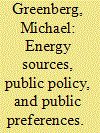

|
|
|
|
|
| Publication |
2009.
|
| Summary/Abstract |
To understand public preferences for energy sources, 2701 US residents were surveyed; 2101 of the respondents lived within 50 miles of a major nuclear facility. Over 90% wanted greater reliance on solar and wind, and over 70% wanted more reliance upon hydroelectric sources. Less than one-third wanted more use of oil and coal. Nuclear and natural gas sources were closer to an even split. Notably, those who lived near nuclear facilities favored the same sources, although a larger proportion of these respondents favored increasing use of nuclear power than in the national sample. These results are consistent with other United States surveys. The study found striking differences in preferences by age, ethnicity/race and other demographic characteristics that need in-depth investigation in order to help decision-makers and everyone else better understand public preferences about energy policy choices.
|
|
|
|
|
|
|
|
|
|
|
|
|
|
|
|
| 17 |
ID:
088962


|
|
|
|
|
| Publication |
2009.
|
| Summary/Abstract |
The grey forecasting model, GM(1,1) was adopted in this study to capture the development trends of the number of motor vehicles, vehicular energy consumption and CO2 emissions in Taiwan during 2007-2025. In addition, the simulation of different economic development scenarios were explored by modifying the value of the development coefficient, a, in the grey forecasting model to reflect the influence of economic growth and to be a helpful reference for realizing traffic CO2 reduction potential and setting CO2 mitigation strategies for Taiwan. Results showed that the vehicle fleet, energy demand and CO2 emitted by the road transportation system continued to rise at the annual growth rates of 3.64%, 3.25% and 3.23% over the next 18 years. Besides, the simulation of different economic development scenarios revealed that the lower and upper bound values of allowable vehicles in 2025 are 30.2 and 36.3 million vehicles, respectively, with the traffic fuel consumption lies between 25.8 million kiloliters to 31.0 million kiloliters. The corresponding emission of CO2 will be between 61.1 and 73.4 million metric tons in the low- and high-scenario profiles.
|
|
|
|
|
|
|
|
|
|
|
|
|
|
|
|
| 18 |
ID:
088989


|
|
|
|
|
| Publication |
2009.
|
| Summary/Abstract |
This article documents and analyzes the changes in fuel efficiency of vehicles on US roads between 1923 and 2006. Information about distances driven and fuel consumed was used to calculate the on-the-road fuel efficiency of the overall fleet and of different classes of vehicles. The overall fleet fuel efficiency decreased from 14 mpg in 1923 to 11.9 mpg in 1973. Starting in 1974, efficiency increased rapidly to 16.9 mpg in 1991. Thereafter, improvements have been small, with efficiency reaching 17.2 mpg in 2006. The information for 2006 was used to calculate the fuel-efficiency improvements in different classes of vehicles that would be needed to achieve a given percentage reduction in the total amount of fuel consumed by all vehicles.
|
|
|
|
|
|
|
|
|
|
|
|
|
|
|
|
| 19 |
ID:
088951


|
|
|
|
|
| Summary/Abstract |
Energy Efficiency
Military
Financing
|
|
|
|
|
|
|
|
|
|
|
|
|
|
|
|
| 20 |
ID:
088968


|
|
|
|
|
| Publication |
2009.
|
| Summary/Abstract |
For over two decades, scientific and political communities have debated whether and how to act on climate change. The present paper revisits these debates and synthesizes the longstanding arguments. Firstly, it provides an overview of the development of international climate policy and discusses clashing positions, represented by sceptics and supporters of action on climate change. Secondly, it discusses the market-based measures as a means to increase the win-win opportunities and to attract profit-minded investors to invest in climate change mitigation. Finally, the paper examines whether climate protection policies can yield benefits both for the environment and the economy. A new breed of analysts are identified who are convinced of the climate change problem, while remaining sceptical of the proposed solutions. The paper suggests the integration of climate policies with those of development priorities that are vitally important for developing countries and stresses the need for using sustainable development as a framework for climate change policies.
|
|
|
|
|
|
|
|
|
|
|
|
|
|
|
|
|
|
|
|
|